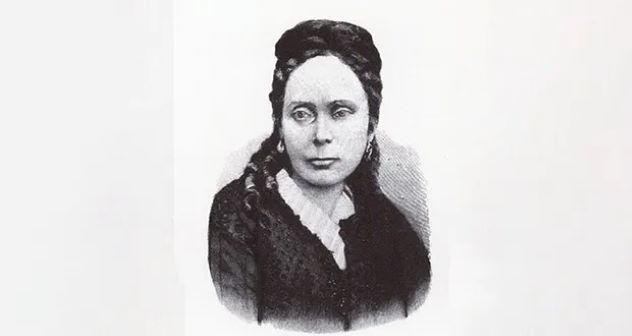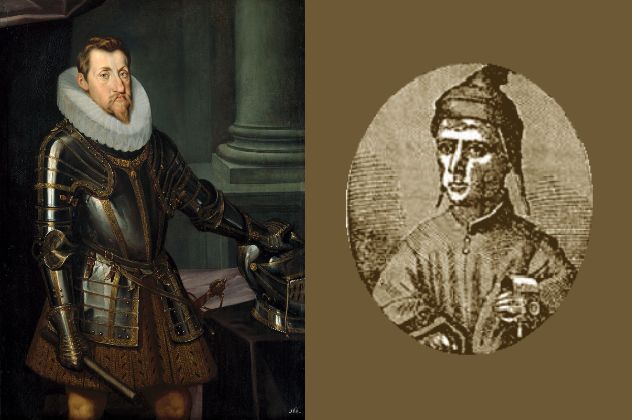 History
History  History
History  Miscellaneous
Miscellaneous 10 Ancient Etiquette Rules You Never Knew Existed
 Our World
Our World Planet Earth’s 10 Most Hardcore Natural Creations
 Movies and TV
Movies and TV 10 Times Twin Movies Competed with Each Other
 The Arts
The Arts 10 Masterpieces Plucked from the Artist’s Subconscious
 Crime
Crime 10 Fascinating Facts about Rikers Island
 Pop Culture
Pop Culture 10 Things You Might Not Know about Dracula
 Weird Stuff
Weird Stuff 10 Everyday Activities That Were Once Considered Illegal
 History
History Ten of History’s Hidden Secrets: Stories 99% Don’t Know About
 Movies and TV
Movies and TV 10 Actors Who Infamously Stormed Off Set While Filming
 History
History 10 Influencers Who Lived Centuries before Social Media
 Miscellaneous
Miscellaneous 10 Ancient Etiquette Rules You Never Knew Existed
 Our World
Our World Planet Earth’s 10 Most Hardcore Natural Creations
Who's Behind Listverse?

Jamie Frater
Head Editor
Jamie founded Listverse due to an insatiable desire to share fascinating, obscure, and bizarre facts. He has been a guest speaker on numerous national radio and television stations and is a five time published author.
More About Us Movies and TV
Movies and TV 10 Times Twin Movies Competed with Each Other
 The Arts
The Arts 10 Masterpieces Plucked from the Artist’s Subconscious
 Crime
Crime 10 Fascinating Facts about Rikers Island
 Pop Culture
Pop Culture 10 Things You Might Not Know about Dracula
 Weird Stuff
Weird Stuff 10 Everyday Activities That Were Once Considered Illegal
 History
History Ten of History’s Hidden Secrets: Stories 99% Don’t Know About
 Movies and TV
Movies and TV 10 Actors Who Infamously Stormed Off Set While Filming
10 Royal Imposters Who Nearly Got Away with It
The Great Pretender is a fascinating TV series based on a Japanese man who uses lies and make-believe to sneak his way into political power. However, there have been some real royal pretenders throughout history.
Here are ten royal imposters who nearly got away with their crimes.
Related: Top 10 Royals That Were Absolutely Crazy
10 Princess Margaret of Norway
Princess Margaret of Norway was a real person, but unlike this imposter, she died at a young age. The real Margaret was born in Norway in 1283 and was betrothed to King Edward II of Scotland at the young age of six. Unfortunately for poor Margaret, when she set sail for Scotland, she fell ill, and the ship had to dock in the Orkney Islands, where she died before she could become queen.
That’s where the fake Princess Margaret comes in. About ten years after the death of the real Princess Margaret, a woman sailed to Norway from Germany and claimed that she was the true heir to the Norwegian throne. According to her, she hadn’t died in the Orkney Islands at all but had instead landed in Germany.
Now she was back, demanding support and claiming her rights to not only the Norwegian throne but also the Scottish throne. This was all despite the fact that she was about 30 years older than the real Princess Margaret would have been if she was still alive!
Of course, the king couldn’t have any of this, so he sent troops to capture the woman and her husband, who she claimed to have married in Germany. The husband was promptly beheaded, and the imposter was burned at the stake.[1]
9 Princess Caraboo
Unlike Princess Margaret, Princess Caraboo didn’t attempt to take the place of a real royal. Instead, she simply invented a position for herself.
Princess Caraboo showed up around Easter in 1817 in Gloucestershire, England, speaking a strange language and carrying a few scant belongings and a counterfeit coin. She used miming to get herself some food and a place to stay at a local inn, and the only word the locals could make out from her was “Nanas,” which is Indonesian for “pineapple.”
Not long after arriving in Gloucestershire and after causing quite a stir in trying to figure out who she was, the woman was introduced to a Portuguese sailor who happened to speak her language. He relayed her story—she was Princess Caraboo from Javasu in Indonesia, who had been captured by pirates and managed to escape by leaping off the boat near Gloucestershire.
Upon finding out she was a “princess,” the woman was quickly introduced into high society, where she became quite famous. Unfortunately for her, her fame meant that her picture was in a newspaper, leading a local landlady to recognize her as someone who she’d housed six months earlier.
When the landlady came forward to confront her, Princess Caraboo could suddenly speak English and revealed that she was really a cobbler’s daughter from Devon named Mary Willcocks. The jig was up, and Princess Caraboo ditched her new name and left for the Americas before returning years later to England, where she died without much notice.[2]
8 Vasily Filatov
Although Anastasia Romanov is the more famous Romanov to go missing, her younger brother Alexei was also never identified. Although historians believe their bodies were simply destroyed after the Romanov murders, many people believe that these two young royals are still out there.
It’s this ongoing belief that allowed Vasily Filatov to make his way into Europe’s high society. Vasily Filatov lived out the majority of his life as a geography teacher in a town called Astrakhan in Russia.
However, right before he died, Vasily suddenly started telling fantastical tales of his life. According to him, he was really Alexei Romanov and had been rescued by soldiers in the palace during the fateful executions of 1918.
Unfortunately for Vasily, he was never able to lay claim to his “heritage.” He died later that year in 1988, leaving only his family swearing by his claims and attempting to restore the Romanov fortune to their name. Of course, no one believed them, and Vasily simply went down in history as another one of many Romanov imposters.[3]
7 Bardiya
Bardiya is a little-known imposter and one of the oldest royal impersonators out there. Historians aren’t exactly sure when Bardiya was born, but what we do know is that he claimed to be the son of Cyrus the Great in Persia. And according to him, that meant he had a right to claim the throne of Persia.
Bardiya took the throne and ruled for eight months before things started to come into question. Darius, another son of Cyrus, began to claim that Bardiya was actually a Persian magi named Gaumata and wasn’t related to Cyrus at all. In fact, the real Bardiya had already been murdered by his brother Cambyses II!
With this story in hand, Darius and several other nobles who were onto the fake murdered the imposter, and Darius took the throne. Today, historians aren’t certain who was the liar—Bardiya or Darius, who just wanted an excuse to be king.[4]
6 Princess Van Wolway
Princess van Wolway, whose real name is Mary Carleton, was born in England but fled to Cologne after being jailed for being married to two men simultaneously. In Germany, she became the lover of a wealthy German nobleman but left in fear of being caught in her lies—with gifts and money he gave her. She then returned to London in 1663 as a self-proclaimed German princess. Mary claimed to be the daughter of the fictional Henry van Wolway, Lord of Holmstein, saying she’d left her home after becoming entangled with an abusive lover.
Upon arriving in England, Princess van Wolway used her wiles to seduce a renowned surgeon, although their marriage didn’t last very long. An anonymous letter exposed her as a crook who was marrying men for their money, and Mary’s marriage was over.
Although she didn’t face any legal troubles for her marriage as Princess van Wolway, her later charades did. Mary went on to live a life of crime, marrying rich men under false identities until one day, the law caught up with her for theft in 1673. She was sentenced to death and hanged that same year.[5]
5 Helga de la Brache

Helga de la Brache was a Swedish con artist who showed up after the exiled King Gustav IV divorced his wife, Frederica of Baden, in 1812. With the king exiled and disgraced, Helga de la Brache had the perfect ploy for fooling the innocent peasants of Sweden.
In 1850, Helga de la Brache began claiming that she was the heir of the king, who had remarried his divorced wife in a convent during his exile. According to her, she had been born in Lausanne and raised secretly by her aunt Princess Sophia Albertine of Sweden. Then she was admitted to an insane asylum to keep her identity under wraps.
After escaping the asylum, she began petitioning the king for a yearly allowance. Her pension was granted until 1876, when suspicions about her identity prompted a trial. The trial revealed that Helga wasn’t Helga at all. Instead, she was Aurora Florentina Magnusson, a poor widower’s daughter. Helga was stripped of her pension and fined but managed to escape more serious repercussions.[6]
4 Anna Ekelöf

Anna Ekelöf was another Swedish imposter, although her story differs a bit from the norm. Rather than posing as a princess, Anna Ekelöf preferred to pose as men.
Her first fraud was in 1765 when she dressed in men’s clothes and masqueraded as Count Carl Ekeblad. Ekelöf got away with her crime for a while, living a life of debauchery and drinking until she was caught.
Once she was caught in that identity fraud, Anna decided to try a different angle. Once again, she dressed in men’s clothing, this time posing as the Swedish Crown Prince. According to her, she’d been forced into exile after plotting uprisings against the Swedish throne.
Anna Ekelöf managed to get away with this second fraud until 1765, when she was caught impersonating royalty and attempting to cross the Norwegian border. However, she escaped custody before her true identity could be revealed. She then seemed to have maintained a low profile for the rest of her life.[7]
3 Lambert Simnel
Lambert Simnel was an imposter who made an attempt at claiming the English throne in 1487. According to him, he was really Edward Plantagenet, the 17th Earl of Warwick and a direct competitor to Henry VII.
Lambert grew up under the care of a priest named Richard Simon, who noticed the boy had an uncanny resemblance to the late Edward IV. Lambert leaped on the comparison, quickly claiming to be Edward IV’s nephew, the Earl of Warwick, who was currently imprisoned in the Tower. According to Lambert, he had escaped the Tower and was now claiming his right to rule.
Lambert quickly gained support from people both in England and Ireland and was crowned as King Edward VI in Dublin in 1487. When King Henry VII caught wind of all this, he was less than impressed. He ordered the real Earl of Warwick to be paraded through London to show the imposter’s true colors.
This plan didn’t work, however, and King Henry VII ended up going to war over the issue against a group of Irish supporters of Lambert. The king won the wars and eventually pardoned Lambert, employing him as a spit-turner in his castle, where he seems to have lived out the rest of his days.[8]
2 Perkin Warbeck
Perkin Warbeck was another English pretender living in the 1400s. Like Lambert, Perkin claimed to be related to Edward IV, this time as his son Richard of Shrewsbury, Duke of York, who had disappeared in the Tower of London.
Perkin began to gain some support from groups both in England and Scotland. Of course, King Henry VII couldn’t have that and denounced Perkin, eventually arresting and confining him to the Tower of London.
Despite this dramatic capture, King Henry VII initially let Warbeck live in the royal court after getting him to admit he was an imposter. However, after an escape attempt eight months later, the fed-up king sentenced Warbeck to death by hanging.[9]
1 Tile Kolup

Tile Kolup is an imposter who claimed to be the Holy Roman Emperor Ferdinand II. In 1250, Ferdinand II died, although rumors were circulating that this was actually a hoax.
Jumping at the chance for a claim to fame, Tile started branding himself as the emperor in 1284. His claims gained him the support of the people in Neuss, Germany. Using fake documents, Tile began holding court sessions in Wetzlar as the emperor.
However, the charade didn’t last long. In 1285, King Rudolph of Habsburg captured the imposter and exposed him for who he really was—a fake. Tile was then burned at the stake for heresy in order to pay for his crimes.[10]








